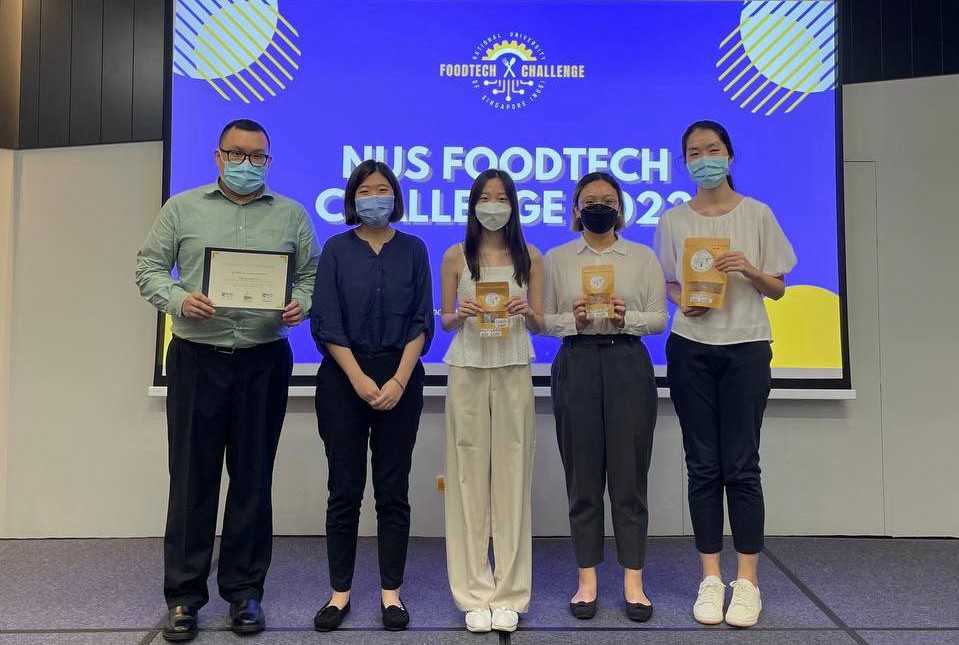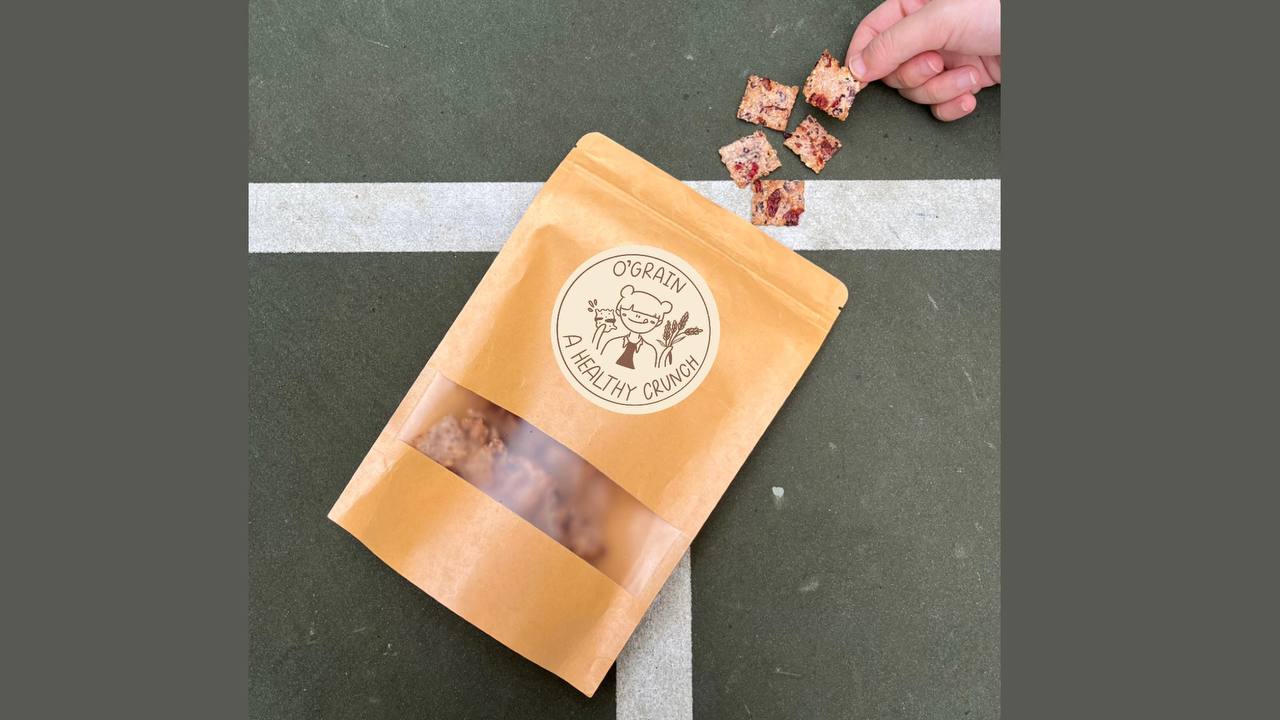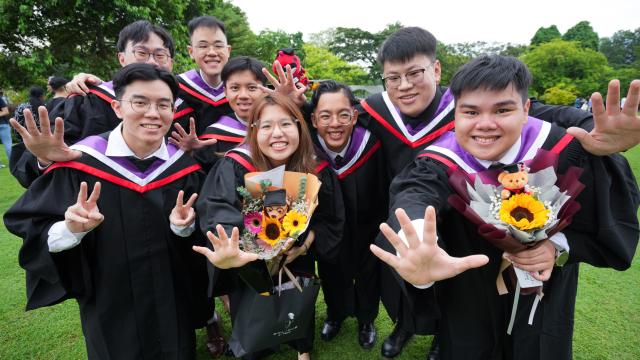SITizens from the SIT-Massey University Food Technology joint degree programme applied their food characterisation and nutrition knowledge to create a healthy snack. They emerged first runner-up among 38 teams that took part in the local track of the NUS FoodTech Challenge 2022.

SITizens Tsai Kok Pow (left), Tang Xin Yi (second from left) and Christine Goh Hui Qin (fourth from left) teamed up with Cheryl Wong Wen Hui from SMU (centre) and Tan Li Fei Phyllis (right) from NUS for the NUS FoodTech Challenge 2022. (Photo: Cheryl Wong Wen Hui)
Award-winning Entry
In July 2022, a team that included three students from the Singapore Institute of Technology (SIT) and Massey University Food Technology joint degree programme emerged first runner-up at this year’s NUS FoodTech Challenge (NUSFTC). The event was organised by the NUS Food Science and Technology Society, NUS Enterprise and the NUS Department of Food Science and Technology, in partnership with Nestlé, International Flavours & Fragrances (IFF) and Perkin Elmer.
In its third year, the challenge is an annual competition that brings students from various tertiary institutions to brainstorm and develop innovative food tech ideas to tackle pressing issues facing the food industry today.
Team ‘O’GRAIN’, comprising team lead Tsai Kok Pow, Tang Xin Yi and Christine Goh from SIT, as well as Tan Li Fei Phyllis from the National University of Singapore (NUS) and Cheryl Wong from Singapore Management University (SMU), clinched first runner-up in the challenge’s local track.
Together with 37 other teams, they had to choose between two problem statements posed by industry partners. O’GRAIN picked IFF’s challenge, which tasked teams to come up with new and unique food concepts that are healthier, tastier, and feature an enhanced textural sensorial experience.
Tackling the Brief
i. Healthier
To address the healthier aspect, O’GRAIN researched pressing health issues facing Singaporeans and neighbouring populations – over-consumption of refined carbohydrates and saturated fats and insufficient fibre intake. These issues lead to obesity, cardiovascular diseases, metabolic syndrome and type 2 diabetes.
Leveraging their food formulation and nutrition knowledge, the team conceptualised a rich-in-fibre rice chip, which incorporated multigrains such as quinoa, brown rice, black rice and sorghum. O’GRAIN also incorporated IFF’s Litesse and Fibrim, which provide soluble and insoluble fibre, into their product.
“In the end, we managed to create a multigrain rice chip that provides one-third of the recommended daily fibre intake for adults,” shared Kok Pow.
The team also managed to reduce the caloric count of their product by using minimal fat and baking their product. “Our product is nutrient dense as most calories come from complex carbohydrates rather than sugar,” said Christine.
ii. Tastier
A common misconception of healthy food was the notion that taste would somehow be compromised. In this aspect, the team sought to use more nutritious ingredients such as cranberries to sweeten the product and formulate a variety of flavours that could entice their target market.
The flavour variations were based on IFF’s range of existing flavours, which included Barbecue and a blend – Jalapeno Tomato. The team could expand the range to include flavours such as Tom Yum, Mala and Matcha, should there be opportunities to commercialise the product.
iii. Sensorial Experience
In coming up with the desired texture, O’GRAIN once again drew on the knowledge acquired on food characteristics.
Shared Xin Yi: “We learnt about what contributes to the texture and sensory properties of various food products. The knowledge came in useful for us to come up with a crispy product using healthier ingredients and cooking methods.”
“We decided to create thin rice chips with a desirable texture that can be achieved using normal baking equipment,” she said.
iv. Sustainable
In addition to IFF’s brief, O’GRAIN went beyond by incorporating an element of sustainability into their product.
For this, they managed to source for okara, a by-product of soya bean that would otherwise be discarded, from local suppliers and incorporated it as an ingredient in their multigrain rice chip recipe. The team explained that while okara is nutritious, it is not often used because of its undesirable taste and texture and tendency to spoil easily.
“Nonetheless, we found that by putting in a bit of effort, we could upcycle something considered as waste into something nutritious,” Kok Pow said.

Healthy, tasty, crunchy and sustainable Multigrain Rice Chips – the brainchild of O’GRAIN’s experiments for NUSFTC 2022. (Photo: Christine Goh Hui Qin)
A Collaborative Effort
When asked about the winning formula behind ‘O’GRAIN’, the team unanimously agreed that each team member brought unique skillsets.
“To develop food products, we need more than just food technologists. Beyond the creation of the product, we also needed marketing support and expertise in commercial processing to bring a product to market,” said Xin Yi. The team roped in Phyllis, who brings expertise in chemical engineering, and Cheryl, who complements the team with her marketing skillset.
Kok Pow added that at SIT, they have been trained to think and work in multi-disciplinary teams, just as what is happening in the real world. “Similarly, in our team, we divided the tasks based on our individual strengths to work through the entire chain of food production, commercial viability, cost efficiencies, marketing and regulatory compliance.”
The team's winning formula is attested not just by their NUSFTC achievements, but also through the possibility of product commercialisation. While talks are still in progress, we are certainly keeping our fingers crossed to see O’GRAIN in the local retail market soon!















![[FA] SIT One SITizen Alumni Initiative_Web banner_1244px x 688px.jpg](/sites/default/files/2024-12/%5BFA%5D%20%20SIT%20One%20SITizen%20Alumni%20Initiative_Web%20banner_1244px%20x%20688px.jpg)


